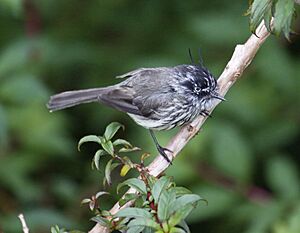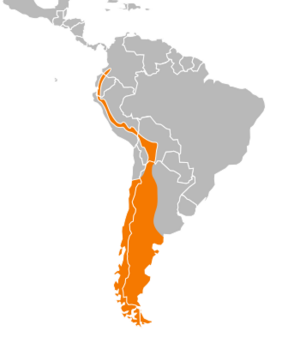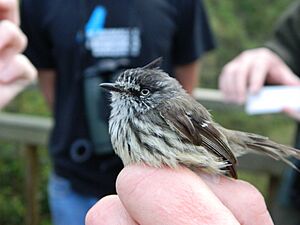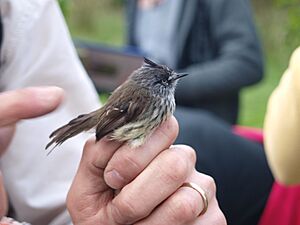Tufted tit-tyrant facts for kids
Quick facts for kids Tufted tit-tyrant |
|
|---|---|
 |
|
| Conservation status | |
| Scientific classification | |
| Genus: |
Anairetes
|
| Species: |
parulus
|
 |
|
| Synonyms | |
|
|
The tufted tit-tyrant (Anairetes parulus) is a small bird. It belongs to the tyrant flycatcher family, called Tyrannidae. This bird lives in western South America. You can find it from southern Colombia all the way down the Andes mountains to Tierra del Fuego.
It likes to live in high mountain forests and bushy areas. However, it can live in many different places. The tufted tit-tyrant has three types, called subspecies. These include Anairetes parulus parulus, A. p. aequatorialis, and A. p. patagonicus. It is very similar to the Juan Fernández tit-tyrant.
This bird is very small. It has a special crest of feathers on its head that stands out. Its head is black with white stripes above and behind its eyes. The back is a dull grayish-brown. Its throat and chest are white with black streaks. The belly is a pale yellow. The different types of tufted tit-tyrants look very similar. This flycatcher sings a lot of different songs.
The tufted tit-tyrant only defends its home against other tit-tyrants. Most of these birds do not migrate, except for those living furthest south. This bird mainly eats insects. It hunts them from small bushes. It usually hunts in pairs. The time when these birds lay eggs changes depending on where they live. They usually lay two or three eggs twice a year. Their nest is shaped like a cup. It is made from roots, grasses, and lichens. Small feathers line the inside. The tufted tit-tyrant is not considered in danger. This is because it lives in a very large area and has many birds.
Contents
Understanding the Tufted Tit-Tyrant's Name
A German explorer named Heinrich von Kittlitz first described the tufted tit-tyrant in 1830. The tufted tit-tyrant is part of a group of birds called Anairetes. This group is in the tyrant flycatcher family, Tyrannidae.
These birds are called "tit-tyrants" because they act like tits. Tits are active birds that move around a lot and have crests on their heads. But the tufted tit-tyrant is actually a type of tyrant flycatcher. In Spanish, this bird is called "Cachudito." This means "little longhorn," which refers to its crest.
There are three main types, or subspecies, of the tufted tit-tyrant:
- Anairetes parulus aequatorialis: This type lives in the northern part of its range. You can find it in the Andes mountains from southern Colombia to western Bolivia and northern Argentina.
- A. p. parulus: This is the original type described by Kittlitz in 1830. It lives in western Chile and southwest Argentina, down to Tierra del Fuego.
- A. p. patagonicus: This type lives in western Argentina. It was described by an Austrian bird expert, Carl Eduard Hellmayr, in 1920.
What Does the Tufted Tit-Tyrant Look Like?
The tufted tit-tyrant is a very small bird. It is about 9.5 to 11 centimeters (3.7 to 4.3 inches) long. It weighs about 6 grams (0.2 ounces). Its long, curved crest of feathers is usually easy to see. Sometimes, the crest looks like two separate crests. The feathers of the crest are black. They grow from the center of the bird's black crown.
The bird's head is mostly black. It has a white stripe above its eye and another behind it. Its eyes are creamy white to pale yellow. The bill is black. The back of the bird is a dull, grayish-brown. Its wings and tail are a darker shade of this color. The wings have two thin white stripes. The outer tail feathers are white.
The throat and chest are white. They have dark gray to black streaks. These streaks become thinner lower down the chest and on the sides. The belly is a pale yellow. This color fades as the feathers get older. The bird's legs are black. Male and female birds look similar. However, females are usually smaller and may have smaller crests. Young tufted tit-tyrants are duller in color. They have a shorter crest. Their wing stripes are a buffy color.
There are only small differences in how the three types of tufted tit-tyrants look.
- Anairetes parulus aequatorialis is usually browner on its upper parts than the main type. It has wider and more streaks on its chest. Its white wing stripes are also wider and clearer.
- A. p. patagonicus is more different from the main type. It is a paler gray overall, especially on its head. Its wing stripes and chest streaks are wider and clearer. Its belly is also a paler yellow or white.
This flycatcher has a loud, high-pitched song. It also makes a fast chuit-chuit-chuit-chuit-chuit-chidi-didi sound. Sometimes, it makes single chuit notes in a slow series of calls. When two tufted tit-tyrants hunt together, they use a perr-reet call. This helps them stay in touch. Their contact call sounds like pluit-pluit. The tufted tit-tyrant also makes a long, soft trill.
Where the Tufted Tit-Tyrant Lives
The tufted tit-tyrant has been seen in Colombia, Ecuador, Peru, Bolivia, Argentina, and Chile. It mainly lives in the Andes mountains in the northern parts of its range. In the south, its range spreads out to include the coast. It has also been seen by chance in the Falkland Islands. This bird is the most common and widespread type of tit-tyrant.
It prefers to live in high mountain forests and bushy areas. But it can live in many different places. You can also find it in elfin forests, the edges of cloud forests, Polylepis woodlands, and bushy forests with Chusquea bamboo. It also lives in disturbed humid scrub, temperate forests, and dry thorn scrub.
This tit-tyrant is most often found between 1,800 and 3,500 meters (5,900 and 11,500 feet) high. However, it can be found at sea level in Chile. It can also live up to 4,200 meters (13,800 feet) high in the Andes.
How the Tufted Tit-Tyrant Behaves
This tit-tyrant seems to protect its feeding area. But it only acts territorial against other tufted tit-tyrants. Birds defending their area often start by calling quickly. They also show signs of stress, like wiping their bill or flapping their wings. Then, they raise their crest and chase the other tit-tyrant through the bushes. Sometimes, they even physically attack the bird that entered their area. The bird that wins then goes back to hunting normally.
The southern type, A. p. patagonicus, migrates to northern Argentina after laying eggs. The other types of tufted tit-tyrants do not seem to migrate.
What the Tufted Tit-Tyrant Eats
The tufted tit-tyrant eats many different insects. Sometimes, it also eats seeds, but this is rare. It is an active hunter. It usually hunts in pairs. After the breeding season, it hunts in small family groups. It has also been seen hunting with groups of different bird species. However, this is not common. When it does happen, it often hunts with the thorn-tailed rayadito. Groups of thirty tufted tit-tyrants have been seen in these mixed hunting groups.
When hunting in pairs, the birds tend to move in a leapfrog style. They always keep an eye on each other. This bird hunts at all levels of its habitat. It hunts from the lower bushes to the tops of the trees.

When hunting, this flycatcher makes many short flights from one branch to another. It prefers to hunt in bushes with small leaves. These include bushes from the Adesmia, Baccharis, and Porlieria groups. A tit-tyrant usually lands near the bottom of a bush. It then moves upwards, flicking its tail up and shaking its wings often. It has also been seen turning on its perch while doing this. When hunting, the tufted tit-tyrant attacks prey about three times per minute. Its hunting style is similar to a kinglet.
The tufted tit-tyrant uses three main ways to catch its food.
- Gleaning: Its main way to hunt is by picking insects off branches while sitting on a perch. When gleaning, the bird sits upright. Its wings hang below its tail, which points straight down. From this spot, the tit-tyrant looks up into the plants for three to five seconds before attacking. This makes them surprisingly careful hunters for such small flycatchers.
- Hover Gleaning: The second most common way to hunt is by hovering. The tit-tyrant flies up from its perch. It then hovers in the air while grabbing prey from the plants.
- Flycatching: A third, less common way is flycatching. The bird flies away from its bush to catch prey in the air. Prey can be caught close to the bird's perch or a short distance away. This often means the bird has to chase its prey. When pairs hunt together, one bird quietly waits in the bush. The other bird snatches nearby insects. After about a dozen attacks, the birds switch places.
Reproduction and Life Cycle
This flycatcher usually raises two groups of young birds each year. The birds in the northern areas build nests from January to June. The birds in the southern areas build nests from August to January. The male tufted tit-tyrant is aggressive during the breeding season. It often chases other males in wavy flights. It makes a whirring sound while doing this.
The tufted tit-tyrant's nest is built in bushes or bamboo. It is often near a stream, open area, or path. The nest is usually well hidden. The nest is small and compact. It is shaped like an open cup. The cup is made of root fibers, lichens, grasses, and thistle down. Small feathers line the inside of the cup. The nests of tufted tit-tyrants are very similar. They only vary a little in what they are made of. Two to three creamy yellow eggs are laid in the nest. The eggs are about 15.1 mm (0.59 in) by 11.8 mm (0.46 in) in size.
Protecting the Tufted Tit-Tyrant
The tufted tit-tyrant is listed as a species of Least Concern. This means it is not currently in danger. This is because it lives in a very large area, about 2,640,000 square kilometers (1,020,000 square miles). Its population is also stable. Even though there is no official count, it is believed to be well over 10,000 birds. This bird is not very common in some places, but it is common in others throughout its range. This species is not easily bothered by human activities in its home.




